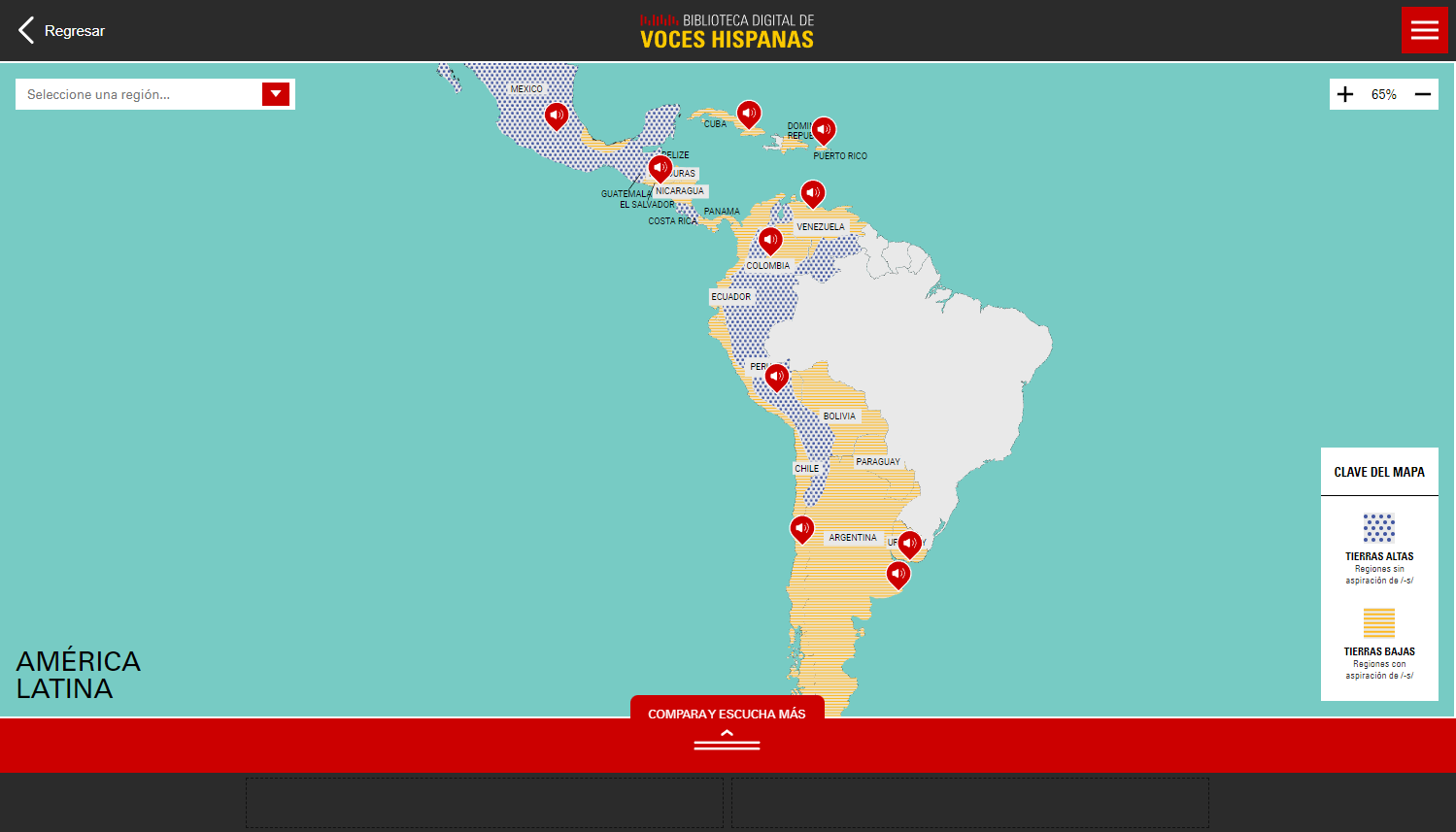DELTA Grant Used to Create Spanish Dialect App

Instructors working with students in language courses understand the complexity of dialects and phonemic features when learning a new language. They also grasp the critical role that hearing and comparing different dialects has for students who are working to improve their skills. But how do you help students overcome the challenge of discerning multiple dialects of a language while in the classroom setting?
Lecturer Inma Navarro, with the NC State Department of Foreign Languages and Literatures, wanted to provide a tool to ensure her students’ success. Receiving a DELTA Grant for the 2021-2022 grant cycle, Navarro worked as the principal investigator (PI) with a team of co-PIs and DELTA staff to develop a better way for students to hear native speakers from different regions.
The DELTA team working on this project was composed of Project Lead Caitlin McKeown, Media Designer Todd Buker, UI/UX and Graphic Designer Brenda Vienrich-Felling, Media Consultant David Tredwell, and Media Developer Andrew Wiedner along with Navarro as the PI and Co-PIs Rebecca Ronquest and Jim Michnowicz.
(Rich Gurnsey was the original project lead and was critical to the early stage of this effort.)
Addressing the Instructional Issues
Initially intended for the course Sounds of Spanish (FLS 333), the team sought to provide a more effective method in learning to recognize acoustic differences among speakers from different Spanish-speaking countries, because phonetic features can be abstract without a context. Previously, instructors used PDFs provided by the textbook publisher that used embedded audio examples, but these PDFs did not include player controls and could not be paused, rewound, or fast forwarded. Other websites had better audio players but provided little context and were not easy to navigate.
The goal was to provide a mobile-friendly solution with a set of interactive audio recordings that would allow students to follow along with transcripts or jump to a specific word or phrase. In addition, geographically accurate maps had to be the centerpiece of the tool, and these maps had to reflect different dialect regions, which do not always correlate with traditional physical or political boundaries.
“Usability was at the heart of every decision we made during the creation of this app,” McKeown said. “The instructors had some adequate audio resources they were using already, but the biggest shortcoming of each was their organization and usability. We knew we needed to solve that problem first if we wanted to create an effective resource for them to use. Everything was designed to maximize user control and to support navigation, both visually with the map and structurally with the UI for the app.”
Working as a Team
The overall development process was multifaceted and overlapping but always a group effort. The team focused on a “divide and conquer” approach with subteams working on different parts of the project. In addition to the core team, the project included a web design team, a development team, and a recording team. Having team members with specialized skills to focus on areas within their expertise allowed the team to tackle issues efficiently as those issues presented themselves.

For example, for the recording team, Navarro paired with Buker from DELTA. Navarro found and scheduled speakers from Spain, Latin America and the U.S., all who were NC State faculty members, staff or students. The team knew they wanted high-quality audio when recording the speakers for the project, so Navarro consulted with Buker and purchased a modestly priced microphone and learned the most effective recording techniques.
Buker also set up a post-production process, including a document with easy-to-follow step-by-step instructions, that Navarro used to enhance the audio files in post production. High-quality audio was critical to the project, so together Buker and Navarro found the right combination of quality and cost for software and hardware. After her training in audio production, Navarro is now better prepared and equipped to produce great audio on her own.
“High-quality audio files were a must, because the application showcases the pronunciation of each speaker,” Navarro said. “It was important for users to compare not only words but sounds within a specific word. For example, our speaker from Argentina pronounces the letter ‘y’ in a word such as ‘yo’ differently from our speakers from Mexico or Chile. Hearing these subtle acoustic differences clearly is an amazing achievement, and I have to thank Todd for this. We spent hours discussing the best locations to record speakers. In addition, he taught me everything I know about sound editing.”
Using subteams to address specific needs, along with regular and frequent meetings, allowed for parallel progress — and a successful launch for the project.
Providing the Solution
The collaborative effort of the team developed a mobile-friendly web-based application that showcases samples of the different acoustic characteristics of formal and informal Spanish dialects. Students can use the app to listen to and compare Spanish dialects, which provides a chance for them to understand these features in real life as well as give them a better understanding of linguistic diversity around the globe, including the variety of Spanish dialects found in the U.S.

Deployed in fall of 2022, The NC State Digital Library of Hispanic Voices app features a series of illustrated intro screens, three interactive maps, an audio player with side-by-side player tabs, and interactive real-time transcripts. Users can follow along with the audio recordings or jump directly to a specific word.
Keeping accessibility in mind, the user can select audio tracks using the map or a drop-down menu to add the recordings to a player drawer. Users can then open and close the drawer to switch between the map and the audio player. The unique design allows students to compare audio tracks side by side with the transcript.
According to Wiedner, maintenance of the app will be handled by the PIs going forward. “They plan to add additional speakers from more regions to the growing digital library and to share it with colleagues at other universities,” said Wiedner. “They hope that it will become an important resource for teaching Spanish dialects beyond NC State.”
Do you need assistance developing course content? Apply for a DELTA Grant for creative delivery solutions to maximize student success.


